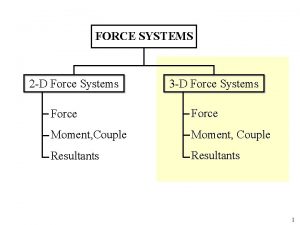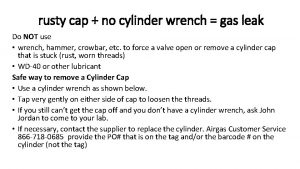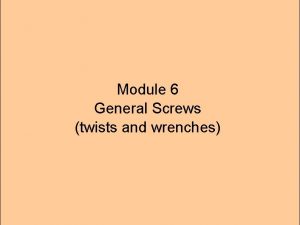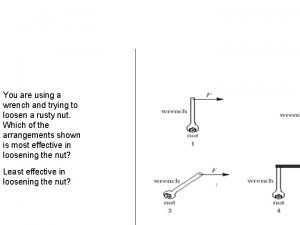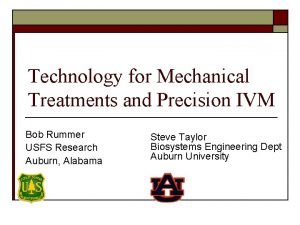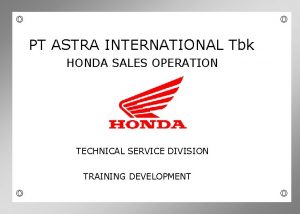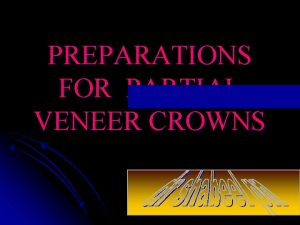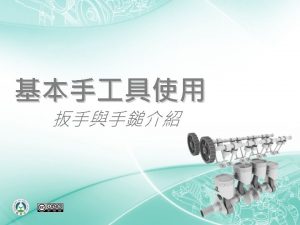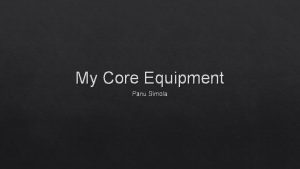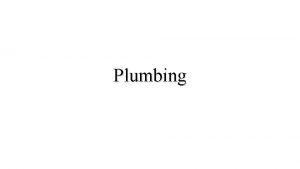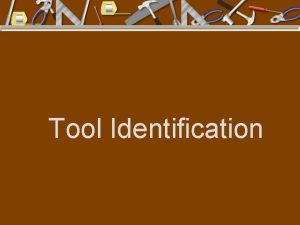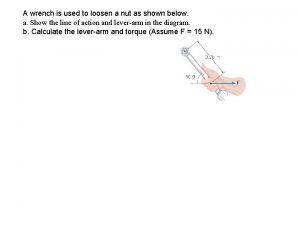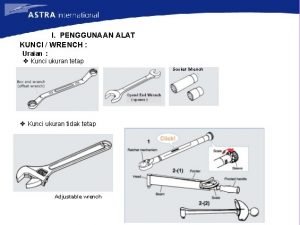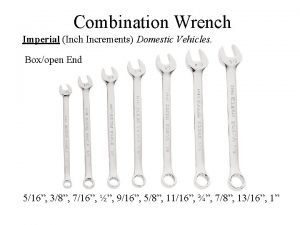1 Using a Wrench You are using a















- Slides: 15


1) Using a Wrench You are using a wrench to loosen a rusty nut. Which 1 2 arrangement will be the most effective in loosening the nut? 3 4 5) all are equally effective

1) Using a Wrench You are using a wrench to loosen a rusty nut. Which 1 2 arrangement will be the most effective in loosening the nut? Since the forces are all the same, the only difference is the lever arm. The arrangement with the largest lever arm (case #2) #2 will provide the largest torque 3 4 5) all are equally effective Follow-up: What is the difference between arrangement 1 and 4?

2) Two Forces 1) yes Two forces produce the same 2) no torque. Does it follow that they 3) depends have the same magnitude?

2) Two Forces 1) yes Two forces produce the same 2) no torque. Does it follow that they 3) depends have the same magnitude? Because torque is the product of force times distance, two different forces that act at different distances could still give the same torque. Follow-up: If two torques are identical, does that mean their forces are identical as well?

3) Closing a Door In which of the cases shown below 1) F 1 is the torque provided by the 2) F 3 applied force about the rotation axis biggest? For all cases the magnitude of the applied force is the same. 3) F 4 4) all of them 5) none of them

3) Closing a Door In which of the cases shown below 1) F 1 is the torque provided by the 2) F 3 applied force about the rotation axis biggest? For all cases the magnitude of the applied force is the same. 3) F 4 4) all of them 5) none of them The torque is: t = F d sin q and so the force that is at 90° to the lever arm is the one that will have the largest torque Clearly, to close the door, you want to push perpendicular!! perpendicular Follow-up: How large would the force have to be for F 4?

4) Balancing Rod A 1 kg ball is hung at the end of a rod 1 1) 1/4 kg m long. If the system balances at a 2) 1/2 kg point on the rod 0. 25 m from the end 3) 1 kg holding the mass, what is the mass of 4) 2 kg the rod? 5) 4 kg 1 m 1 kg

4) Balancing Rod A 1 kg ball is hung at the end of a rod 1 l 1) 1/4 kg m long. If the system balances at a 2) 1/2 kg point on the rod 0. 25 m from the end 3) 1 kg holding the mass, what is the mass of 4) 2 kg the rod? 5) 4 kg The total torque about the pivot must be zero !! The CM of the same distance rod is at its center, 0. 25 m to the right of the pivot Since this must balance the ball, which is the same distance to the left of the pivot, pivot the masses must be the same !! m. ROD = 1 kg X 1 kg CM of rod

5) Mobile A (static) mobile hangs as shown below. The rods are massless and have lengths as indicated. The mass of the ball at the bottom right is 1 kg. What is the total mass of the mobile? 1) 5 kg 2) 6 kg 3) 7 kg 4) 8 kg 5) 9 kg ? 1 m 2 m ? 1 kg 1 m 3 m

5) Mobile 1) 5 kg A (static) mobile hangs as shown below. The rods are massless and 2) 6 kg have lengths as indicated. The mass 3) 7 kg of the ball at the bottom right is 1 kg. 4) 8 kg What is the total mass of the mobile? 5) 9 kg Use torques in two steps: (1) find the big mass on the bottom ? left (lower rod only). (2) use the 1 m entire lower rod assembly (with two masses) to find the mass on top right. Finally, add up all the masses. 2 m ? 1 kg 1 m 3 m

6) Tipping Over I A box is placed on a ramp in the configurations shown below. Friction prevents it from sliding. The center of mass of the box is indicated by a blue dot in each case. In which case(s) does the box tip over? 1 1) all 2) 1 only 3) 2 only 4) 3 only 5) 2 2 and 3 3

6) Tipping Over I A box is placed on a ramp in the configurations shown below. Friction prevents it from sliding. The center of mass of the box is indicated by a blue dot in each case. In which case(s) does the box tip over? 1) all 2) 1 only 3) 2 only 4) 3 only 5) 2 and 3 The torque due to gravity acts like all the mass of an object is concentrated at the CM. Consider the bottom right corner of the box to be a pivot point. If the box can rotate such that the CM is lowered, it will !! 1 2 3

7) Tipping Over II Consider the two configurations of 1) case 1 will tip books shown below. Which of the 2) case 2 will tip following is true? 3) both will tip 4) neither will tip 1 2 1/4 1/2 1/4

7) Tipping Over II Consider the two configurations of 1) case 1 will tip books shown below. Which of the 2) case 2 will tip following is true? 3) both will tip 4) neither will tip The CM of the system is midway between the CM of each book. Therefore, the CM of case #1 is not over the table, so it will tip 1 2 1/4 1/2 1/4
 Mikael ferm
Mikael ferm Wrench resultant
Wrench resultant Cylinder cap wrench
Cylinder cap wrench Chasles rule
Chasles rule Autotorque hydraulic chain pipe wrench
Autotorque hydraulic chain pipe wrench Bust a knuckle
Bust a knuckle Engineering mechanics chapter 2 solutions
Engineering mechanics chapter 2 solutions A ladybug is clinging to the rim of a spinning wheel
A ladybug is clinging to the rim of a spinning wheel Weed wrench
Weed wrench Valve adjusting wrench berfungsi
Valve adjusting wrench berfungsi Reversed three quarter crown
Reversed three quarter crown Wrench meaning
Wrench meaning You say that you love rain
You say that you love rain Good health is a choice agree or disagree
Good health is a choice agree or disagree If you think you can you can poem
If you think you can you can poem Tell me what you eat and i shall tell you what you are
Tell me what you eat and i shall tell you what you are

